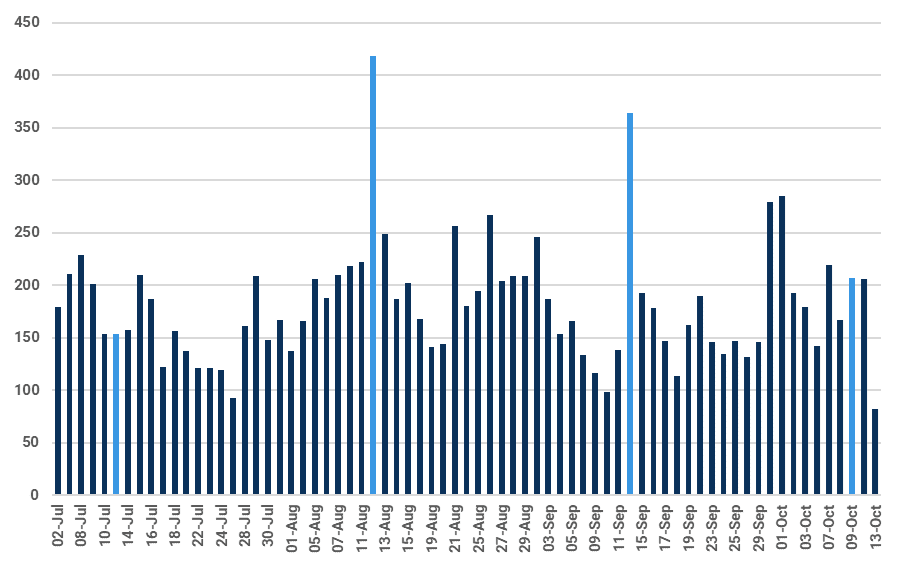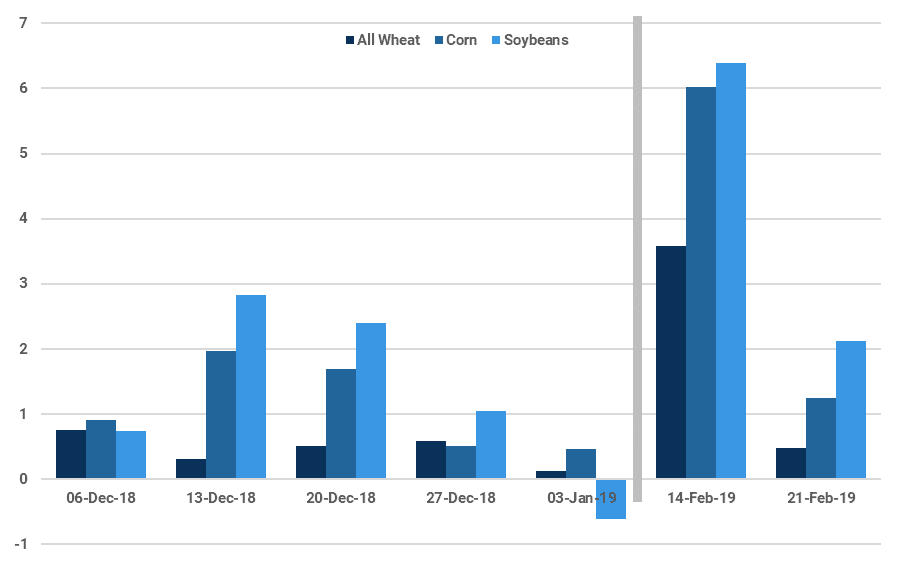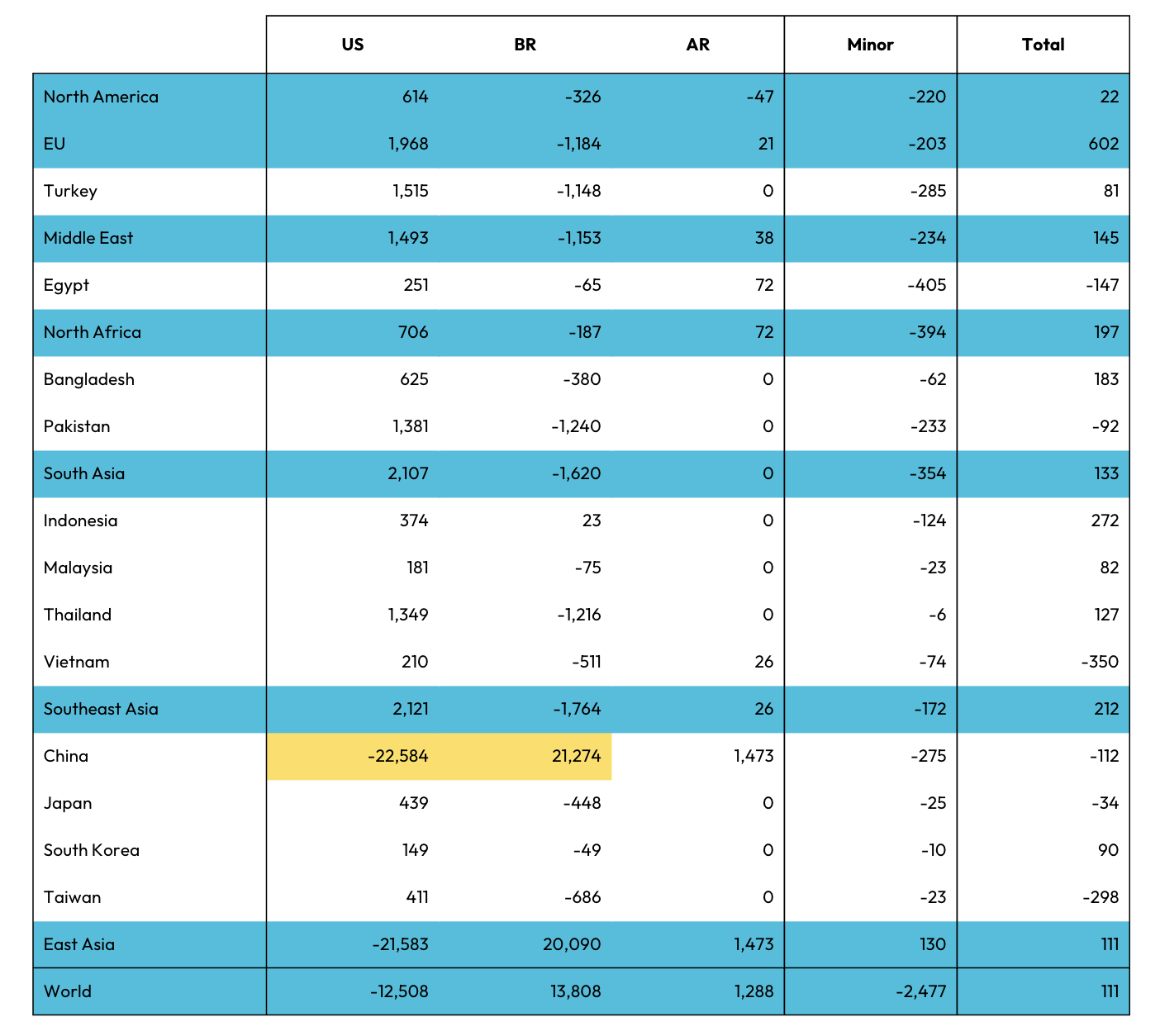Suspended USDA reports put the market on a tightrope
The US government shutdown is affecting a large number of non-essential services throwing life in limbo for government workers and those who depend on the government’s services. For the commodities markets, reduced functioning at the USDA and other key organisations will affect farm programs and data releases. The market has come to rely on government data to understand and trade agricultural markets. Lack of releases will bring significant opacity to commodity fundamentals. Kpler commodity flow data, supply and demand module and Insight bring much needed transparency to users.
Impact on markets
Lack of regular data updates will impact both the physical supply chain as well as purely financial players.
Without the USDA’s guidance on key balance sheet metrics such as sales and production updates, farmers and merchandisers will operate with limited and outdated information. Farmers who relied on this information to decide when and how much to sell will now get most of their information from the downstream supply chain, which may not be in their best interest.
Merchandisers and traders also position themselves based on fundamentals. At this time in the season, they look for official releases (export sales, crush and stocks) to understand demand. Most will be flying blind. They will have to depend on information flow through trade channels directly involved in consumption or exports, such as crushers and export elevators.
While it may take some time for the effect to be felt by physical players, futures traders will miss every release. Over time, the industry has started to closely trade each piece of information released by the USDA in both discretionary and systematic ways.
Algorithms which traded every WASDE and export sales report will become useless for the time being. So will the strategies that traded farmer, index and fund positioning through CFTC’s report.
Volatility-based strategies that traded irrespective of price direction will also struggle. Data shows the volume peak around the WASDE report did not happen in October (see chart below). The exchange, CME in this case, will not be happy with the reduced volume.
Volume surge around WASDE report absent in Oct for corn Dec’25 (k lots)

Source: Barchart
Why has it impacted USDA publications
The lapse in US government funding has seen only mission-critical services continue, such as food safety, conservation, and emergency programs. However, for other remits, the USDA has ceased operation. So, all publications by the National Agricultural Statistics Service (NASS) have ceased during the shutdown. Although USDA data that has been released can still be accessed via NASS Quick Stats, so far.
When has it happened before
The 35-day US government shutdown from Dec 2018 to Jan 2019 was the longest on record and led to the suspension of the Jan 2019 WASDE report. The 16-day shutdown in Oct 2013 also caused the cancellation of that month’s WASDE release. However, the shutdown does not only impact the release of USDA reports that had been scheduled prior the shutdown. Reports that are scheduled shortly after the shutdown is lifted may also be postponed by several weeks.
Additionally, weekly updates for CFTC’s Commitment of Traders report are suspended. Like the USDA reports, once the shutdown is lifted, the report may not initially show the weeks of data that would have been available if the shutdown hadn’t occurred.
Key reports that will be missed
WASDE: The report that that will be missed by most of the market is the monthly WASDE report that was due to be published on 9th October. While several private analysts and newswires have been publicising estimates for what the October WASDE could have contained, the absence of affirmation still leaves a cloud of doubt. For example, only two months ago had the USDA raised US corn yield from 181.0 bu/ac to 188.8 bu/ac, far from the average analyst estimate and driving considerable movement for CBOT corn futures. Kpler has recently published its updated balance sheets for October.
Export Sales: Given the above-average sales of corn and contrasting picture for soybeans, export sales had been focal for interpreting how strong the export campaign will be for both crops during the current marketing year. Corn sales had been driving much surprise considering Brazil’s record safrinha corn harvest earlier in the year. While, for soybeans, the market had been attentive of any Chinese purchases. Although the continuation of weekly U.S. inspections offers some insight into how well exports are performing, they will come after the fact. For either crop this year, the loss of sales reporting adds uncertainty into the market.
Missed export sales are reported in the week after the shutdown ends (Mt)

Source: USDA
Commitment of Traders: While not overseen by the USDA, the Commitment of Traders report is also no longer being updated. Given the weight of influence these Funds have in the market, as well as the duration they typically hold positions for, this helped to indicate market sentiment. Without weekly updates regarding the positions of these Funds, this barometer has been lost. During the US government shutdown in 2018/19, Funds had closed out a net long corn position and moved to net short before the data had become available. This had spooked the market as most believed Funds would have remained net long.
Longer-term implications
Should the current shutdown surpass the longest on record during Dec 2018 to Jan 2019, it will increasingly reduce the transparency of the corn, soybean, and wheat markets. Looking ahead, there should be two WASDE reports before the end of the calendar year. For these publications, the adjustments made by the USDA to US balance sheets, as well as the other major exporters and importers, helps to inform market fundamentals. The next less frequent but highly influential USDA report is Grain Stocks at the start of January, which helps to inform the markets understanding of US crop fundamentals. Also in January is the Winter Wheat and Canola seeding report.
Ag Outlook Forum: In February, the USDA usually hosts an Agricultural Outlook Forum of which they produce initial estimates for the upcoming market year. This can offer a first glance for US corn and soybean acreage for 2026.
Prospective Plantings: Towards the end of March, the Prospective Plantings report is usually published. The data within this report comes from a survey conducted by NASS and is therefore seen as a reliable insight into what farmers are considering to plant. There is also another quarterly report for Grain Stocks.
In May, the USDA usually publishes its first WASDE estimates for the 2026/27 marketing years, which consequently influences how the market feels about supply in the current marketing year.
Acreage: Then for June, the USDA publishes the Acreage report, which is a revised outlook regarding US corn and soybean production. Lack of USDA reports casts a large shadow over agricultural markets
There are several other important releases such as Crop Progress and Grain and Oilseed Crushings which also frequently add valuable insight.
Using Kpler data to fill the void
At Kpler, balance sheets for the major exporters of Corn, Soybeans, and Wheat are revised and published monthly, two days in advance of the WASDE report. Back-tests show Kpler balances are often months ahead of the USDA by using detailed models of global trade. For instance, Kpler correctly forecast the direction of USDA’s ending stock change 15 out of 16 times for 2024/25. Similarly, Kpler has reflected to lack of soybean sales to China in the 2025/26 US balance sheet since April, something the market realised in the months that followed. The granularity of the trade matrix in the Kpler balance sheets evidences the fundamental analysis behind the market calls.
Another example of this is Chinese corn demand for 2024/25. In its January report, Kpler forecast Chinese corn imports for 2024/25 at 5 Mt compared to the USDA at 13 Mt. While monitoring import demand, Kpler adjusted import demand below 3 Mt in February. In contrast, the USDA gradually lowered Chinese import demand to reach 3 Mt in September, only after it was realised.
At the core of Kpler data is cargo tracking. Using over 250 hard sources, Kpler tracks global seaborne grain movements in real-time. This gives users access to export data akin to export inspections, ahead of time, and for all exporting countries. This is especially valuable in tracking flows for countries where regular data is not available, such as Russia, or the US at the moment.
Sneak peek into Kpler Grains S&D
US soybean balance sheet (US units)

Notes:
- US ending stocks will rise to over 12% s/u mainly led by low exports due to loss of Chinese demand
- Despite higher domestic crush and lower area, stocks will remain elevated in 2026/27
Soybean export changes (2025/26 - 2024/25, Sep-Aug)

Notes:
- US exports will be 12.5 Mt lower y/y in 2025/26, they will be substituted by exports from Brazil
- Loss of 22.5 Mt of Chinese demand is tough to make up despite increased exports to all other destinations

Uncover risks before regulators do
See Kpler's Risk & Compliance insights in action.






